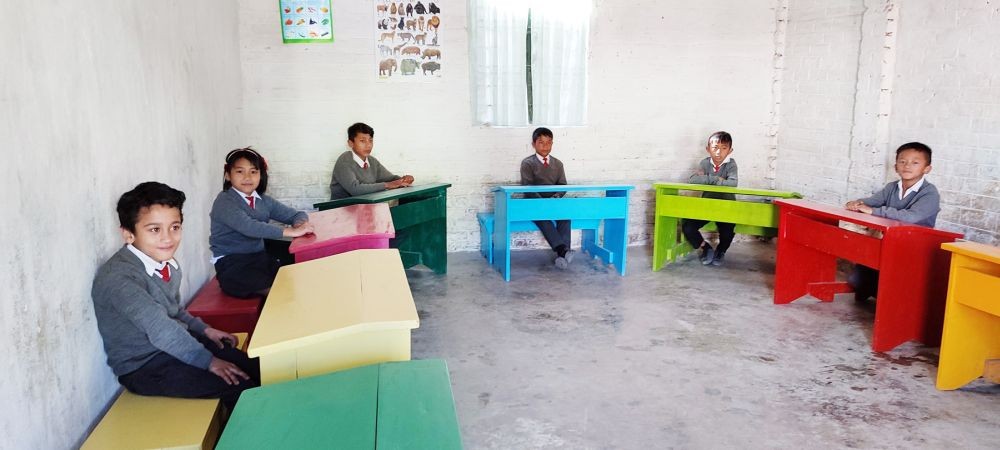GPS students in Jotsoma. The vibrant benches and desks are a result of the NECTAR Performance Incentive Grant (PIG) towards enhancing the classroom ambience. (Morung Photo)

Vishü Rita Krocha
Kohima | November 5
In its effort towards strengthening community participation in the education system across government schools in Nagaland, the World Bank funded Nagaland Education Project- The Light House, NECTAR (Nagaland Enhancing Classroom Teaching and Resources) has seen positive results through the implementation of one of its components called ‘Performance Incentive Grants’ (PIG).
While serving as a reminder to the community of their ownership responsibilities towards their respective government schools, the first batch of PIG also witnessed a resurrection of the SMCs (School Management Committee) and SMDCs (School Management Development Committees) in their involvement and participation in the schools. In the first batch, a total of 738 government schools in the state were approved for the grant.
In less than a year, these government schools have witnessed notable transformation in several aspects. Some of these were replacing leaking roofs, painting the school buildings, purchasing new desks, benches, furniture, computers and other equipment, floor plastering, renovation of toilets, building fencing etc. It also triggered a number of activities involving skill development and traditional learning systems usually not seen in government schools.
In an exclusive interview with The Morung Express, Principal Director of School Education, Thavaseelan K, IAS termed the PIG as the “Crown Jewel of the NECTAR Project” while elucidating that the implementation process has so far, been extremely successful with the community spearheading the effort. “We are also trying to figure out if there is a way to enhance and support the schools more under the project,” he added.
Highlighting that SMCs and SDMCs have taken complete ownership in this regard, he said that the majority of the schools have done exceedingly well. Categories of intervention under the project include community engagement, school development, classroom development, extra-curricular and other innovations besides monitoring. Thavaseelan K further observed that monitoring has also helped a lot in the success of the project.
During a visit to the Government Primary School (GPS) Phezhu in Jotsoma, SMC Chairman, Khriebu Nakhro related that there has been an increased involvement of the community towards the education of the children in the school. He also expressed belief that the record keeping and maintenance (which is a requirement for all the beneficiary school), will further enhance quality education including transparency.
At Government Higher Secondary School (GHSS), Jotsoma, the Principal, Azinu Savi Swuro affirmed that there has been very high community participation in the school. When the school did not have a room to start the Higher Secondary, she said, it was the community that came forward to renovate the girls’ hostel to be used as a classroom. A new classroom extension was also built with 80% of community contribution besides providing volunteer teachers for one month when there was lack of one.
Pelevito Nakhro, an elderly member of SDMC also expressed gratitude for the Grant while stating that with the implementation of the project, it is the community that is doing the work as opposed to the time when work was often taken up by contractors.
Increase in enrolment of students in govt schools
With the ‘Performance Incentive Grant’, government schools have also seen an increase in enrolment of students through Community outreach programs. A case in point is the GPS at Kezoma that enrolled a total of 12 new students in the middle of the academic session following the community outreach program.
While government schools have the best qualified teachers and resources, the trend has been that private schools are more often sought after. In this context, NECTAR is trying to educate the public to enroll their children in government schools, for which, it also recognises that the role of community is crucial.
In Jotsoma, schools observed that many students dropped out of school during the COVID-19 lockdown. However, with the enrolment drive under PIG, it was learnt that these dropouts are willing to come back to school from the next academic session. SMC Chairman, Khriebu Nakhro remarked that they have seen an increase in enrolment as well as increase in admission of local students while explaining that earlier, the students in the school comprised mostly of domestic helps and children of daily wage earners.
However, with a greater sense of community ownership, the trend is slowly changing.
Towards this end, Thavaseelan K also cited schools that have already seen an increase in enrolment. He further articulated that ensuring the schools have good infrastructure and teachers who deliver, which are the other parts of the NECTAR project, would put things in place.
“Once everything is in place, we hope the results in government schools will eventually surpass that of private schools,” he explained while reiterating that as and when everything falls into place, the enrolment will automatically take care of itself.






